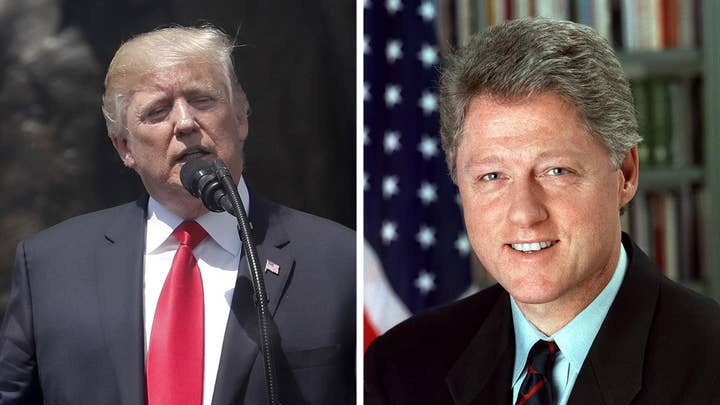House Democrats intensify push for impeachment
Reaction from Matt Bennett, senior vice president and co-founder of Third Way and former deputy assistant to President Clinton, and Trent Duffy, partner at HDMK and former deputy press secretary to President George W. Bush.
CAPITOL HILL – This may not be as intriguing as the recent debate over whether cereal is soup.
But, questions are swirling around the Capitol as to how a Senate trial may proceed should the House of Representatives actually impeach President Trump.
First of all, the House actually would have to impeach the president. This could be on a sole article of impeachment or several. In 1998, the House considered four articles of impeachment for then-President Clinton.
The House ultimately impeached Clinton on two of the four articles. Those articles went to the Senate. The House also selected “impeachment managers” to prosecute the case against Clinton. Those “managers” were House members. In fact, three impeachment managers from the Clinton impeachment trial remain in office today: Reps. Steve Chabot, R-Ohio, and Jim Sensenbrenner, R-Wis., along with now-Sen. Lindsey Graham, R-S.C. Graham was in the House at the time.
Some insiders have wondered whether Senate Majority Leader Mitch McConnell could try to short-circuit a trial to protect the president.
On Sept. 24, I asked McConnell if the Senate would entertain articles of impeachment should the House send them across the Capitol. The Kentucky Republican sidestepped my question.
“I’m not going to address all of these – hypotheticals,” McConnell said at the time. “I think all of that is premature.”
A few hours later, Pelosi formally announced the House was launching an impeachment inquiry.
But, during an appearance this week on CNBC, McConnell suggested a Senate trial would be in the offing.
“I would have no choice but to take it up. How long you’re on it is a whole different matter, but I would have no choice but to take it up based on a Senate rule on impeachment,” McConnell said.
The majority leader was referring to a set of 24 established rules the Senate designed long ago for impeachment trials. The Senate currently has 44 “standing rules” which govern its operations. Such decrees are so hallowed that it requires a procedural vote of 67 yeas to alter a standing rule. The Senate’s directives for impeachment aren’t part of those standing rules, but Fox News has been told it would require a supermajority of 67 to change the impeachment edicts. McConnell conceded that point on CNBC. In other words, there’s no easy way for the Senate to wiggle out of considering the House’s impeachment articles.
But...
I have covered McConnell for a long time now, and, as I wrote in this space as recently as August, one must parse McConnell’s words for acute detail. Over the summer, McConnell said the Senate would have “discussions” about guns. Naïve ears interpreted that as an actual floor debate on firearms. It’s now early October – and the Senate has never put a gun bill on the floor. Yet, there have been “discussions.”
REPORTER'S NOTEBOOK: WHAT MCCONNELL SAID AND DID NOT SAY ON GUNS
On CNBC, McConnell said that under the Senate’s rules, “I would have no choice to take it up.” He also said, “how long you’re on it is a whole different matter.”
Therein lies the rub. Let’s explore what “taking it up” means as well as “how long” the Senate could devote to impeachment.
Senate impeachment Rule I says, “Whensoever the Senate shall receive notice from the House of Representatives that managers are appointed on their part to conduct an impeachment against any person and are directed to carry articles of impeachment to the Senate, the Secretary of Senate shall immediately inform the House of Representatives that the Senate is ready to receive the managers for the purpose of exhibiting such articles of impeachment, agreeably to such notice.”
In other words, the Senate says to the House, “Watcha got?” The “Whensoever” is important. That means Senate action happens automatically.
Senate impeachment Rule II says the “impeachment managers” then parade over to the Senate, are recognized on the Senate floor, and “the articles shall be exhibited.” Fox News is told this involves a reading of the articles of impeachment on the Senate floor.
Now, what happens after is up for interpretation. At that point, the Senate, as McConnell said, has “taken up” impeachment. But, as McConnell also said, for “how long?”
This is why history is an important guide. The House has sent over articles of impeachment only on 19 occasions in the history of the republic. When it comes to actually impeaching a President? Well, that may happen only once a century.
McConnell’s office pointed reporters this week to a 1986 memo from then-Senate Parliamentarian Bob Dove to then-Senate Secretary for the Majority Howard Greene about impeachment. In the missive, Dove told Greene the Senate sent the articles of impeachment for President Andrew Johnson to a committee before his trial in 1868. Dove pointed out that it happened before the Senate approved its set of impeachment rules. If the Senate wanted to route the articles to committee, it likely would require a two-thirds vote to overcome the present-day impeachment rules. It’s doubtful that dispatching the articles to a committee will happen in this instance. But, such a tactic could be a way to euthanize the articles, effectively bottling them up. If it did happen, Fox News is told a committee likely would conduct its own investigation, like the House.
But, we don’t have to go back to 1868 to get a sense of what could happen this time.
In January, 1999, then-Senate Majority Leader Trent Lott, R-Miss., and Minority Leader Tom Daschle, D-S.D., assembled a “caucus of 100 senators” in the Old Senate Chamber in the Capitol. Usually, senators meet in separate caucuses, based on party, but Lott and Daschle wanted to forge a universal, bipartisan compromise on how the Senate would handle Clinton’s impeachment trial. The senators agreed how to hear from the managers and the president’s counsel, and to establish time restrictions. Even if senators differed on whether to convict Clinton or exonerate him, they at least agreed on “trial” operations and how to sit as jurors.
The trial would happen... except for one thing.
Legendary Sen. Robert Byrd, D-W.Va., said he wanted to dismiss the charges. Perhaps the Senate wouldn’t have tolerated such a motion from any other senator, but Robert Byrd was Robert Byrd, perhaps one of the five most influential figures in the history of the body. Byrd was a former majority leader, a talented orator, and perhaps most importantly, the guardian of the Senate’s prerogatives, rules and precedents.
When Robert Byrd spoke, people listened.
In January 1999, Byrd introduced a resolution “that the impeachment proceedings against William Jefferson Clinton, President of the United States, be and the same, are duly dismissed.” But, the Senate rejected Byrd’s entreaty. The Senate trial continued.
Despite the Standing Rules of the Senate and the Senate’s impeachment rules, regular motions appear to be subject to a simple majority during a trial. Thus, if a current senator were to move to dismiss the articles of impeachment, ala Byrd in 1999, the Senate could flush the trial with a majority vote. That’s fairly easy. Thus, McConnell’s “how long” point.
In this hyper-polarized environment, it’s hard to see how McConnell and Senate Minority Leader Chuck Schumer, D-N.Y., possibly could forge an agreement as Lott and Daschle did over two decades ago with a “caucus of 100.” Some Republicans may demand the Senate dismiss the articles. Some Democrats wouldn’t budge from conducting a trial. But, there are currently 53 Republicans in the Senate. One source close to the process told Fox News, “the majority will set out the rules of the road” for any prospective trial of President Trump.
It’s important to note that the Senate has never terminated an impeachment trial before. And, there are questions as to whether the Senate could end such a trial against the will of the minority. Remember, the minority controls lots of power in the Senate.
But, there is one instance of the Senate not actually conducting a trial following a House impeachment.
The House of Representatives voted to impeach U.S. District Judge Samuel Kent on June 19, 2009 on charges of sexual assault, obstruction and lying to investigators. The House sent the articles to the Senate. But, Kent resigned on June 30, before a Senate trial. So, the Senate voted to dispense with the articles of impeachment on July 22.
It takes a two-thirds vote to convict an impeached person and remove him or her from office. With 53 Senate Republicans, few analysts have thought there’d be any chance the Senate could vote to evict Trump from office. Article I, Section 3 of the Constitution says that a Senate conviction would trigger “disqualification to hold and enjoy any Office of honor, Trust or Profit under the United States.” But, the person still could be tried in a court of law.
CLICK HERE FOR THE ALL-NEW FOXBUSINESS.COM
So, if the House impeaches Trump, the Senate will have to “take it up,” but what happens after presenting the articles is far from clear.
After all, this has happened only twice before. And, usually, once a century.









